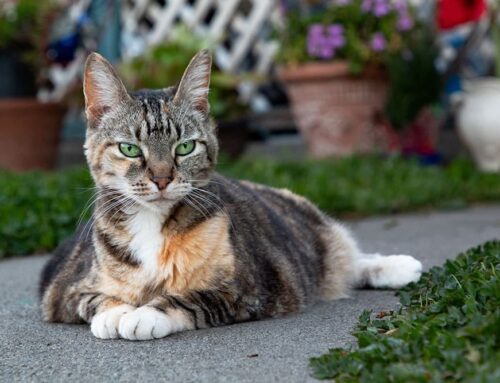Understanding Chronic Pain in Aging Cats
As cats age, they often develop chronic pain conditions that significantly impact their quality of life. Unfortunately, because cats instinctively hide signs of pain, these conditions can go unnoticed until they become severe. Arthritis, dental disease, and cancer are among the most common causes of chronic pain in senior cats.
Recognizing and managing chronic pain early can greatly improve your cat's comfort and well-being.
Signs Your Senior Cat May Be in Pain
Cats do not always show obvious signs of discomfort. Instead, they may display subtle behavioral changes that indicate something is wrong. If you notice any of the following, it could be a sign that your cat is experiencing chronic pain:
Reduced mobility – Hesitating to jump, avoiding stairs, or moving stiffly
- Changes in grooming habits – Overgrooming a painful area or neglecting grooming altogether
- Increased vocalization – Meowing more frequently, especially at night
- Shifts in behavior – Becoming more withdrawn, irritable, or aggressive
- Loss of appetite – Decreased interest in food, leading to weight loss
If you observe any of these signs, a veterinary evaluation is essential to determine the cause and create an appropriate pain management plan.
Learn how to assess mobility in aging cats
How Just Cats Clinic Diagnoses Chronic Pain
The Importance of Veterinary Assessment
Because cats instinctively mask pain, a thorough veterinary evaluation is necessary to uncover underlying health issues. At Just Cats Clinic, we conduct:
- Comprehensive physical exams to assess mobility and joint health
- Diagnostic imaging (X-rays, ultrasound) to identify arthritis, fractures, or tumors
- Blood tests to rule out underlying diseases like kidney disease, hyperthyroidism, or diabetes
A precise diagnosis allows us to customize a pain management plan that meets your cat's specific needs.
Advanced Pain Management Options for Senior Cats
Laser Therapy: A Non-Invasive Solution
Laser therapy is a drug-free treatment that helps reduce inflammation, relieve pain, and promote healing. It is particularly beneficial for arthritis, soft tissue injuries, and post-surgical recovery.
Benefits of laser therapy include:
- Reduced inflammation and stiffness
- Improved circulation and tissue healing
- Pain relief without medication
Learn more about laser therapy for cats
Acupuncture for Natural Pain Relief
Acupuncture is a safe, holistic approach to pain management that stimulates nerve function and increases circulation. Many cats tolerate acupuncture well and experience significant pain relief with regular sessions.
Read more about veterinary acupuncture
Additional Pain Management Strategies
Depending on your cat's diagnosis and needs, we may recommend:
- Pain-relief medications – NSAIDs, gabapentin, and other pain management drugs tailored to feline patients
- Joint supplements – Glucosamine and omega-3 fatty acids to support joint health
- Massage therapy & rehabilitation – Gentle physical therapy to improve flexibility and comfort
- Weight management – Reducing excess weight helps minimize joint strain and enhances mobility
Discover the benefits of pet massage therapy
Helping Your Cat Feel Comfortable at Home
Small adjustments to your home environment can make a big difference in your cat's daily comfort.
Simple Ways to Improve Your Cat's Quality of Life
- Provide soft, orthopedic bedding to cushion sore joints
- Use pet ramps or steps to help your cat access beds, couches, or windowsills
- Place food, water, and litter boxes on the same level to minimize unnecessary movement
- Use a heated bed or warm blankets to help soothe stiffness and discomfort
Regularly observing your cat's mobility and behavior will help you recognize when additional adjustments or veterinary care may be needed.
Recognizing When Pain Becomes an Emergency
While chronic pain can be managed with routine care, some symptoms require immediate veterinary attention. Contact us if your cat experiences:
- Sudden inability to walk or stand
- Significant swelling or acute lameness
- Excessive vocalization or signs of severe distress
- Complete loss of appetite for more than 24 hours
Seeking prompt treatment can prevent further complications and improve your cat's comfort.

Why Choose Just Cats Clinic for Your Cat's Pain Management?
At Just Cats Clinic, we specialize in feline-exclusive care, meaning your cat receives expert, compassionate treatment in a stress-free environment.
What Sets Us Apart?
- AAHA-accredited, maintaining the highest standards in veterinary medicine
- Certified Cat-Friendly Practice, ensuring a comfortable, low-stress experience
- Advanced pain management techniques, including laser therapy and acupuncture
Our goal is to enhance your cat's quality of life through proactive pain management and personalized care plans.
Learn more about our Cat-Friendly Practice
Frequently Asked Questions About Managing Chronic Pain in Cats
How much does chronic pain management cost?
The cost varies depending on the type of treatment, such as medications, laser therapy, or alternative treatments. We offer customized care plans to fit your budget and your cat's needs.
How often should senior cats be checked for pain?
Senior cats should have twice-yearly check-ups to monitor for signs of pain, though more frequent visits may be needed if symptoms worsen.
Can chronic pain in cats be cured?
While many chronic conditions cannot be cured, they can be effectively managed to ensure your cat remains comfortable and active.
Learn about feline rehabilitation and mobility support
Schedule a Pain Management Consultation for Your Cat
Your senior cat deserves to live a comfortable and pain-free life. If you suspect they are experiencing chronic pain, early intervention is key to preventing further deterioration.
Book a Consultation at Just Cats Clinic













